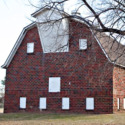The local newspaper printed the following letter to the editor on Jan. 10, 2011. I photographed the “sister barn” this weekend. Here are both letter and photo together.
—
I grew up with the “sister barn” to the barn that sits on the West Des Moines Valley High School campus. Our barn sits on what is left of our family’s century farm just south of Ashworth Road on 60th Street – County Line Road.
Both barns were built at approximately the same time. My grandfather, Walter E. Barnes, learned of the 39th Street barn being built and decided to build one as well. My father was 13 when our barn was built circa 1936, just before electricity arrived to its location. The barn was wired for electricity, which arrived about a year after its completion.
My grandfather provided the building materials and three men provided the labor in exchange for the beef from one cow, approximately enough to feed a family for a year. The completed barn housed the horses that worked the fields, including one that pulled the single-row corn planter behind which my father learned to plant corn. There were stanchions for milking cows, shelter for animals and the largest of haylofts to store hay for the animals. There was a large swinging metal tub that traveled along a metal track hung from the ceiling used for hauling manure from the barn.
My father eventually converted the dairy stanchions to farrowing pens for raising pigs.
My father’s work and our lives centered on the barn and its buildings, including a hog house, corn cribs, machine shed, milk house, tool shop, oil house, chicken house, silos and more.
Every summer we helped fill the barn with hay. And the cribs were filled with corn, oats and beans. We threw down bales of hay from the loft for the cattle and helped with the baby pigs. Tractors had replaced the horses, but some of the harness equipment remained along with my father’s knowledge of how to harness and drive a team of horses.
I was standing in the Jordan Creek Town Center parking lot several years ago and looked out over the city’s growth and was startled to see our barn among the sea of the houses.
In my father’s last years, when the city was engulfing the farm, he often joked about getting lost amid the progressing development. He would say, “If I can find the barn, then I know I can find my way home.”
When we destroy our visual history, we are in danger of losing our way home. We have only the written and verbal record to reference the past.
Other cultures have kept much of their structural past even amid their growing cities. Boston, Cairo, Rome, Paris and Jerusalem are just a few examples. Is Holland anxious to remove its windmills or Scotland its castles or ruins?
I saw the inside of the 39th Street barn as it was filmed for a Tuesday evening television newscast. It is beautiful, irreplaceable and a great work of craftsmanship and art. I have always admired Valley High School for valuing and maintaining the barn. I am already grieving at the possibility that it will soon be razed.
Are we too tired to figure out a way to save and incorporate the barn into our environment or to build around it? For more “green space” one literally needs to travel west to Madison and Dallas counties, where our small community of 1,000-plus citizens has been working to save our first public two-story stone schoolhouse built circa 1872.
The barns and schools were some of the first buildings to rise from the prairie. Communities once worked to raise the barns and now they let them go to be razed.
– Annie Barnes Braland, Earlham





Leave a comment
Comments feed for this article